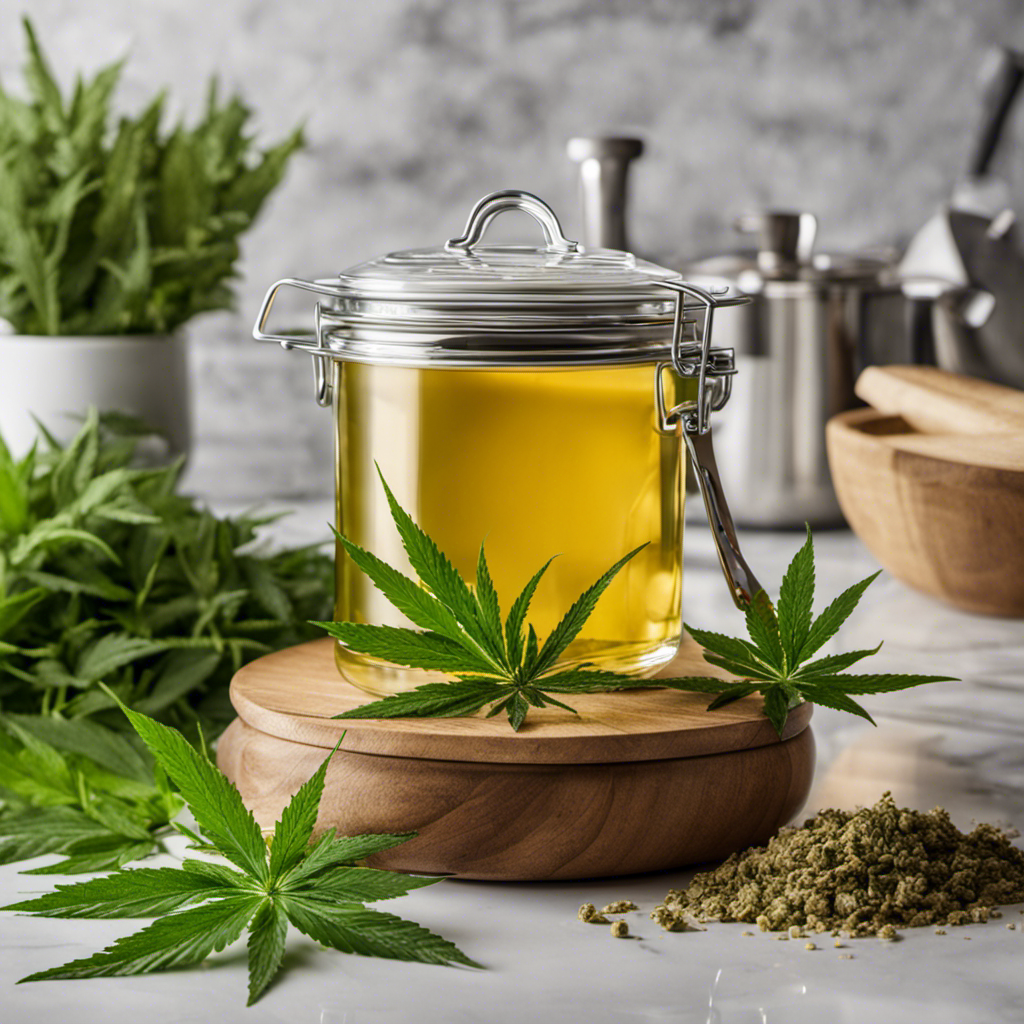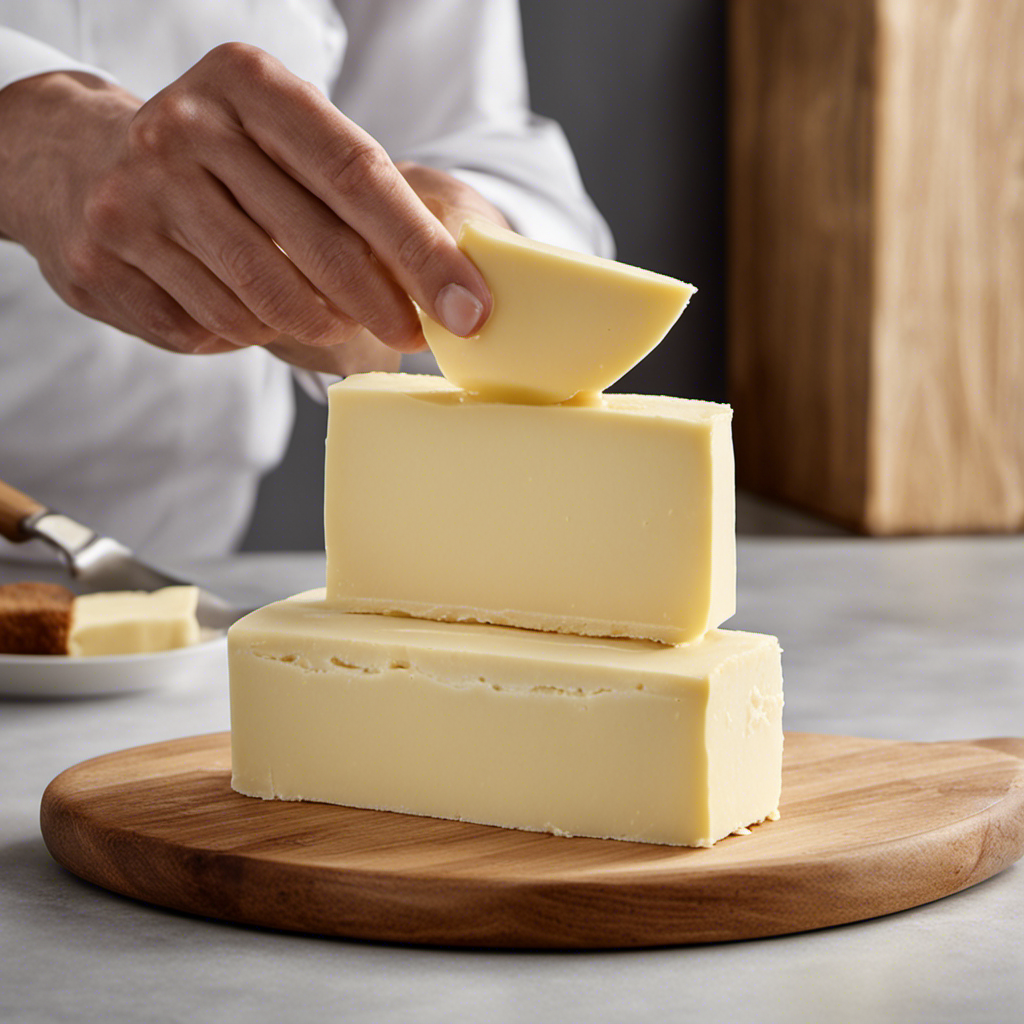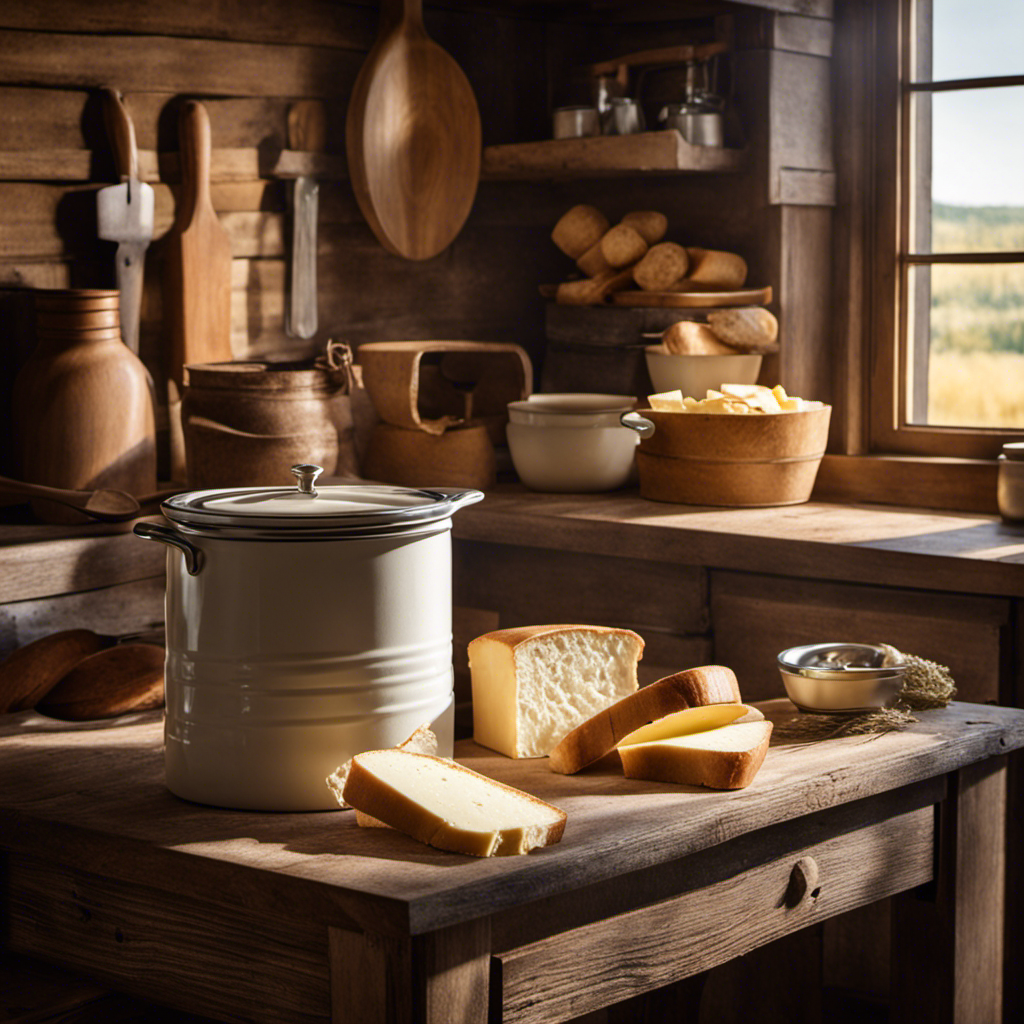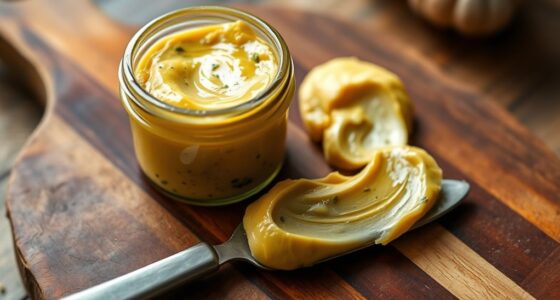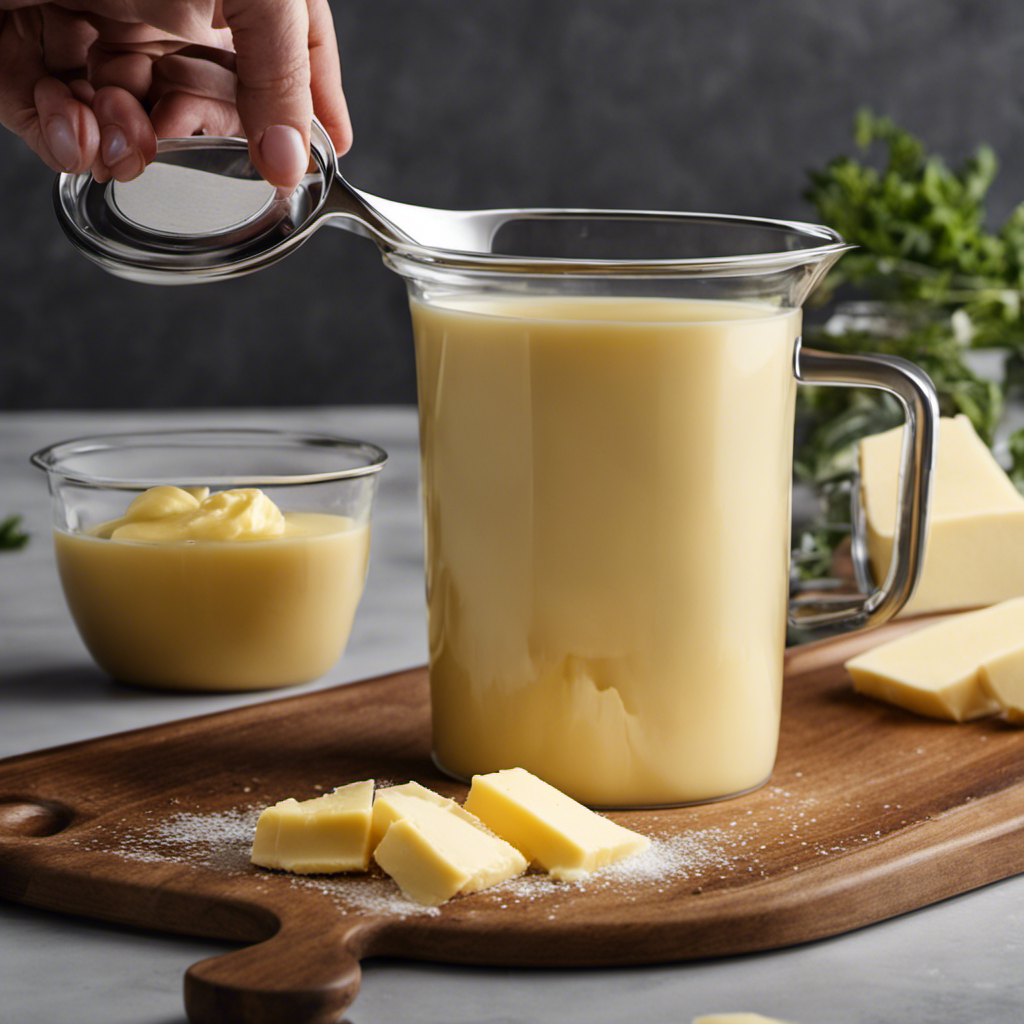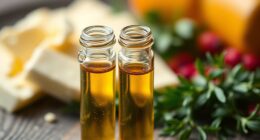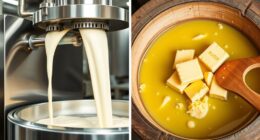So you’re interested in learning how to make CBD butter, huh? You’re in luck! In this article, I’ll walk you through the process of making your own CBD-infused butter step by step.
We’ll cover everything from choosing the right CBD product to gathering the necessary ingredients and supplies. By the end, you’ll have a delicious and versatile butter that you can use in a variety of recipes.
So, let’s get started on this buttery adventure!
Key Takeaways
- CBD butter is a versatile product that can be used in various recipes and provides an easy way to incorporate CBD into daily routine.
- CBD butter offers a non-psychoactive alternative to traditional edibles and allows for precise dosage control.
- CBD butter enhances the flavor profile of dishes and its effects last longer compared to smoking or vaping.
- When making CBD butter, it is important to choose the right CBD product, follow a step-by-step guide, and store it properly for freshness and potency.
What Is CBD Butter
CBD butter is a versatile product that can be used in various recipes. It is a simple and effective way to infuse CBD into your favorite dishes. To make CBD butter, you will need CBD oil or CBD isolate and unsalted butter.
Start by melting the butter in a saucepan over low heat. Once melted, add the desired amount of CBD oil or CBD isolate to the butter and stir until well combined. Allow the mixture to cool and solidify before using it in your recipes.
CBD butter can be used in a wide range of dishes, from baked goods to savory dishes like pasta or vegetables. Its versatility makes it a popular choice for those looking to incorporate CBD into their daily routine.
Now that we know how to make CBD butter, let’s explore why using CBD butter can be beneficial.
Why Use CBD Butter
When it comes to the health benefits of CBD, it’s clear that this compound has a lot to offer. From reducing anxiety and stress to alleviating pain and inflammation, CBD has been shown to have a positive impact on various aspects of our well-being.
In addition to these benefits, CBD also provides an alternative to traditional edibles, allowing users to enjoy the therapeutic effects without the psychoactive properties of THC. This makes it a versatile option for those looking to incorporate CBD into their wellness routine.
Health Benefits of CBD
To reap the health benefits of CBD, you should consider incorporating it into your daily routine. CBD, or cannabidiol, is a natural compound found in cannabis plants that has been shown to have numerous potential benefits for our well-being.
When it comes to CBD dosage, it’s important to start low and gradually increase until you find the right amount for you. It’s always best to consult with a healthcare professional to determine the appropriate dosage based on your individual needs.
While CBD is generally well-tolerated, potential side effects may include fatigue, dry mouth, and changes in appetite. However, these side effects are typically mild and temporary.
Incorporating CBD into your daily routine can help alleviate symptoms such as anxiety, pain, and insomnia.
As we explore alternatives to traditional edibles, let’s take a look at how to make CBD butter.
Alternative to Traditional Edibles
As we delve into different options, let’s consider an alternative way to enjoy the benefits of cannabis-infused edibles. CBD butter recipes provide a versatile and effective method of incorporating CBD into your cooking. By infusing butter with CBD, you can easily add it to a wide range of dishes, from baked goods to savory dishes.
To understand the benefits of using CBD in cooking, let’s take a look at the table below:
| Benefits of CBD in Cooking |
|---|
| 1. Provides a discreet and convenient way to consume CBD |
| 2. Allows for precise dosage control |
| 3. Enhances the flavor profile of dishes |
| 4. Provides a longer-lasting effect compared to smoking or vaping |
Using CBD in cooking not only offers these benefits but also allows for a more enjoyable and personalized experience. But before we proceed, let’s discuss how to choose the right CBD for your butter in the next section.
Choosing the Right CBD for Your Butter
It’s important to consider the right CBD product for your butter to ensure the desired effects. When choosing CBD for your butter, there are a few things to keep in mind:
-
CBD dosage: Determine the desired strength of your butter by considering the dosage of CBD you want per serving. This will help you achieve the desired effects without overdoing it.
-
Cooking methods: Different CBD products have different heat tolerances. If you plan to cook your butter at high temperatures, opt for CBD isolates or distillates which are more heat-stable. If you prefer a milder cooking method, CBD oils or tinctures can be added after the butter is cooked.
-
Flavor profiles: Consider the flavor of the CBD product you choose. Some CBD oils or tinctures may have a strong, earthy taste that can affect the overall flavor of your butter. Choose a product with a flavor profile that complements your recipe.
By considering these factors, you can select the right CBD product to infuse into your butter and create a delicious and effective end result.
Now, let’s move on to gathering the ingredients and supplies for our CBD butter adventure.
Gathering the Ingredients and Supplies
When it comes to making CBD butter, having the right tools and ingredients is crucial for success.
The essential tools you will need include a double boiler or a saucepan and a heatproof bowl, a fine-mesh strainer or cheesecloth, and a spatula or spoon for stirring.
As for the ingredients, you will need high-quality CBD oil or CBD isolate, unsalted butter, and optionally, lecithin to enhance the absorption of CBD.
Finding these supplies can be as easy as visiting your local health food store or ordering them online from reputable CBD retailers.
Essential Tools and Ingredients
You’ll need a few essential tools and ingredients to make CBD butter. Here are the recommended items:
-
Tools:
-
Double boiler: This will help you melt the butter and CBD oil together without burning them.
-
Whisk or wooden spoon: Use this to stir the mixture and ensure even distribution of the CBD oil.
-
Cheesecloth or fine mesh strainer: This will help you strain out any plant material or impurities from the finished butter.
-
Ingredients:
-
Unsalted butter: Choose high-quality unsalted butter for the best flavor and texture.
-
CBD oil: Look for a high-quality CBD oil that is specifically made for culinary use. Make sure it is lab-tested for potency and purity.
-
Water: Adding a small amount of water to the butter and CBD oil mixture will prevent it from burning.
With these essential tools and ingredients, you’ll be well-equipped to make your own CBD butter at home. Just follow the recipe and enjoy the benefits of this versatile cannabis-infused ingredient.
Where to Find Supplies
To find the necessary supplies for your CBD butter recipe, start by checking local health food stores and specialty shops in your area. These stores often carry a variety of CBD products, including CBD oil or tinctures that can be used to make CBD butter. You can also inquire if they carry any CBD-infused food products that can be used in your recipe.
If you prefer the convenience of buying online, there are numerous reputable websites that specialize in selling CBD products. Make sure to read customer reviews and check for third-party lab testing to ensure the quality and purity of the CBD products you purchase.
Now that you know where to find the supplies, let’s move on to the step-by-step guide to making CBD butter.
Step-by-Step Guide to Making CBD Butter
First, mix the decarboxylated CBD flower with butter to start the process of making CBD butter. This simple recipe will allow you to infuse the butter with the therapeutic properties of CBD, making it a versatile ingredient for all your cooking and baking needs.
Here’s a step-by-step guide to making CBD butter:
- Start by finely grinding the decarboxylated CBD flower.
- In a saucepan, melt the butter over low heat until it becomes liquid.
- Add the ground CBD flower to the melted butter and stir well.
- Simmer the mixture on low heat for 2-3 hours, stirring occasionally.
- After the infusion period, strain the mixture through a cheesecloth or fine mesh strainer to remove any plant material.
- Let the CBD butter cool and solidify before transferring it to an airtight container for storage.
With your homemade CBD butter, you can create a wide range of CBD-infused dishes like cookies, brownies, or even savory dishes like CBD-infused buttered vegetables. The possibilities are endless!
Storing and Using Your CBD Butter
When storing your CBD-infused butter, be sure to keep it in an airtight container in the refrigerator to maintain its freshness and potency. Storing CBD butter properly is crucial to ensure its longevity and effectiveness.
The refrigerator provides a cool and stable environment that helps preserve the cannabinoids present in the butter. Exposure to heat, light, and oxygen can degrade the CBD, reducing its potency over time.
By keeping it in an airtight container, you create a protective barrier against external elements that could compromise the quality of your CBD butter.
When using CBD butter, start with small amounts and gradually increase the dosage as needed. CBD butter can be used in a variety of ways, such as spreading it on toast, adding it to recipes, or even using it topically for skincare. Experiment and find what works best for you!
Tips and Tricks for Making the Best CBD Butter
Now that you know how to store and use your CBD butter, let’s dive into some tips and tricks for making the best infused butter. Trust me, with a little knowledge and practice, you’ll be whipping up delicious and potent CBD-infused treats in no time.
Here are some key pointers to keep in mind when making infused butter:
- Quality ingredients: Start with high-quality CBD oil or hemp flower to ensure the best results.
- Proper dosing: Calculate the desired CBD dosage per serving and adjust the amount of CBD oil or hemp flower accordingly.
- Infusion methods: Choose between decarboxylation, slow cooking, or using a double boiler to extract the CBD into the butter effectively.
Creating a visual image, imagine the following:
- A fragrant kitchen filled with the aroma of freshly ground hemp flower.
- A simmering pot of butter gently infusing with CBD, releasing its therapeutic properties.
- Creamy, golden CBD butter ready to be incorporated into your favorite recipes.
Frequently Asked Questions
Can CBD Butter Be Used in Baking Recipes?
Yes, CBD butter can be used in baking recipes. It adds a unique twist to both savory dishes and dessert recipes. Incorporating CBD butter into your baking can provide a relaxing and enjoyable experience.
Is CBD Butter Safe for Children to Consume?
As a parent, I understand the concern about CBD butter’s safety for children. It’s important to consult with a pediatrician for appropriate dosage and be aware of potential side effects before giving it to kids.
Can CBD Butter Be Used as a Substitute for Regular Butter in Cooking?
Yes, CBD butter can be used as a substitute for regular butter in cooking. It has a slightly different taste, but it can still add richness and flavor to savory dishes.
How Long Does It Take for CBD Butter to Take Effect?
To enhance the effects of CBD butter and experience quicker results, there are a few methods you can try. One is to consume it on an empty stomach, while another is to use a sublingual method by placing it under your tongue.
Can CBD Butter Be Infused With Flavors Like Vanilla or Lavender?
Yes, CBD butter can be infused with flavors like vanilla or lavender. Adding these flavors not only enhances the taste but also provides additional therapeutic benefits. Vanilla-infused CBD butter can promote relaxation, while lavender-infused CBD butter can help with stress and anxiety.
Conclusion
In conclusion, making CBD butter is a simple and effective way to incorporate CBD into your daily routine. By following the step-by-step guide provided, you can create a homemade CBD butter that suits your preferences and needs.
While some may argue that buying pre-made CBD products is easier, making your own CBD butter allows you to have full control over the ingredients and dosage. Plus, it can be a fun and rewarding experience.
So why not give it a try and enjoy the benefits of CBD butter?
